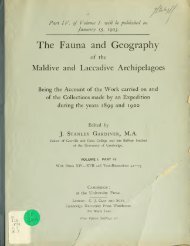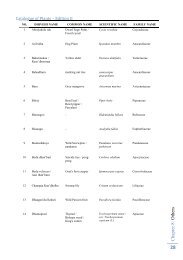(582 L. A. BORRADAILE.typical members of the Oxyrhyncha—the Maiidae'—have adopted another plan. They hidethemselves by covering their bodies with bits of seaweeds, zoophytes, or sponges, which areheld on by hooked or jagged hairs of special shape found on the body and limbs of thetrue spider-crabs and not elsewhere (PI. XLVII. figs. 3 c and 4 d). They are gathered andplaced in position by the crab itself, which uses for this purpose its chelipeds. These limbsare specially shaped so as to have a mobility not found in other crabs, and are thus ableto reach distant parts of the body and legs. In order that they may adhere better, thefragments of weed, etc. are treated with a secretion given out by glands on the firstmaxilliped"; and they not only remain in a living state, but often continue to grow, sothat in some genera it is not un<strong>com</strong>mon to find the whole crab as <strong>com</strong>pletely hidden bya single sponge as any Dromia. Besides seaweeds, the organisms used include sponges,hydroids, polyzoa, and ascidians, and in some cases barnacles and tubicolous worms addthemselves as self-invited guests. Several different kinds of organisms may sometimes befound on the back of one crab, but in most cases, very jjossibly in all, the species plantedby it are those amongst which it is living and are changed if it be placed in othersurroundings where they would be conspicuous. This implies considerable care in the choiceof the clothing, and indeed such may easily be seen to be bestowed if a captive individual,say a Maia squinado, be watched while it is disguising itself I have even seen this speciesQover its back with shingle when no weed was available. The number of hairs naturallyvaries, as does also the extent to which the crab is hidden, but it rarely happens (E'pialtus)that they are quite wanting.' Key to the fumiliei! of the Oxyrhyncha.I. Carapace thin and flat. First leg (cheliped) not long orspecially mobile or with fingers bent at an angle with thehand. Male opening sternal. [No orbits. Second jointof antennal stalk slender,fused with epistome but notwith front. No hooked hairs.] Hymenosomidae.II. Carapace not thin and flat (except Ocinopus). First legeither mobile or powerful with bent fingers.coxal.Male openingA. Chelipeds specially mobile, rarely much larger thanthe other legs or with fingers bent at an angle on thehand.Second joint of antenna well developed, generallyfused with epistome and often with front. Orbitsgenerally more or less in<strong>com</strong>plete. Hooked hairsalmost always present.Maiidae.B. Chelipeds not specially mobile, usua!l3' much longerand heavier than the other legs and with fingers benton the hand at an angle towards the side on whichthe fixed finger is set. Second joint of antenna small,short, and not fused with epistome or front.Orbitswell made. Hooked hairs almost always wanting.Parthenopidae.Key to the subfamilies of the Maiidae.I. Second joint of antenna very slender throughout its length.II.[No orbits. Eyestalks generally long.] Inachinae.Second joint of antenna not very slender.A. No true orbits (eyestalks hidden under a supraocularspine or sunken in the sides of a great rostrum).Second joint of antenna truncate-triangular. Eyestalksvery short. Acanthonychinae.B. True orbits, containing both supra- and postocularelements sheltering the eyes, are more or less <strong>com</strong>pletelyformed, except in a few genera where theeyestalks are long and slender. Second antenna-jointbroad, usually not truncate-triangular. Eyestalks longor short.1. A large, cupped, usually blunt postocular processpresent. Eyestalks short. Cornea of eyes not <strong>com</strong>pletelyhidden when they are folded back. Pisinae.2. Postocular process, if present, usually .sharp and notcupped, but if not so then cornea hidden (as alsoin most other cases). Eyestalks usually long.Maiinae.Key to the subfamilies of the Parthenopidae.I. Carapace usually triangular, sometimes suboval or subpentagonal.Bostrum simple. Chelipeds much biggerthan the other legs. Branchial regions of the bodydeeply separated from cardiac. Parthenopinae.II. Carapace usually sharply pentagonal. Rostrum cleftinto two. Chelipeds of moderate size. Branchialregions of the body not deeply separated from cardiac.Euniedoninae.- For an account of those structures in the Spider-Crabswhich are specially adapted to their habit of clothing themselves,see Aurivillius, Kong. Scenska Vet.-.ik. Hand. Bt.XXIII. no. 4 (1889).
MARINE CRUSTACEANS. 683Such habits as these need a corresponding habitat, and the Spider-Crabs are essentiallyhaunters of weeds, and weed-like animals. The larger kinds cling to the rocks and stoneson which grow the organisms they clothe themselves with. The walking-legs of such speciesusually end in strong, shai-p, curved claws by which they can hold fast to the ground.Smaller kinds often live on the weed itself, and these frequently bear hooked or evensub-chelate claws on the hinder legs with which to cling to the branches, while one orboth of the second and third pairs are long — probably because they are used in climbing(PI. XLVII. figs. 1, 3 and 4). The first pair (^chelipeds) are also sometimes used, monkeywise,in clambering. Research will no doubt show that some of the peculiar features ofparticular species and genera are adaptations to special kinds of sessile organisms. At presentI can only recall the flat, leaf-like body of Huenia, which resembles the Haliiueda-weedamong which it is generally found (see below, p. 686), and it is certainly the case thatvery many species show no preference whatever in this respect.The habit of living on or among sessile organisms is probably kept up by some ofthe members of the other two families of the Oxyrhyncha, although it is the Maiidaealone which clothe themselves in the way described above. Further information, however,is much needed on this point. The Hymenosomidae (Fig. 122) seem clearly adapted bytheir structure—their delicate bodies and slender legs with hooked end-joints—for living onplants or zoophytes. They may certainly sometimes be found in such situations, but arealso reported to have been taken under stones', a position for which their flat backs arenot unsuitable. Among the Parthenopidae, the Eumedoninae are probably guests of otherorganisms. Zehrida has, indeed, been taken among the spines of a sea-urchin whose colouringit assumes. But the Parthenopinae (PI. XLVII. fig. 5) have an entirely different habitat.The members of this subfamily have left the weed (that they originally had the samehabits as the Maiidae seems likely from the occurrence of hooked hairs, slight and few innumber, in certain members of the genus Lamhrus) and have taken up the same habitatas the Oxystomata—that is to say beds of sand and shingle. The result is a series ofmodifications strikingly like some of those which are found in the latter group-. Theoverlapping wings of the carapace which hide the legs of Calappa and Tlos reappear insuch forms as Cryptopodia, Heterocrypta and Oethra and less strongly marked in Larahrus,especially L. calappoides. The long chelipeds of some Leucosiids are repeated in an alteredshape in various species of Lamhrus and Parthenope. The bent fingers of Ranina and somespecies of Calappa are found throughout the group. In Lamhrus calappoides we find againthe flat hands of Calappa held against the breast. But the most striking of these likenessesis the arrangement of the inward channel for the breathing-stream in Aulacolamhrus, which,while it is wholly new, yet strongly recalls that of the Leucosiidae. In this subgenus, theunderside of the carapace (pterygostome) is traversed, on each side, just outside the thirdmaxilliped, by a deep groove which is covered in, not like the analogous channel in theLeucosiidae by the maxillipeds, but by thick fringes of hairs borne by the maxillipeds andby the carapace, be<strong>com</strong>ing thus a closed tube leading from the front of the body to theopening of the gill-chamber at the base of the chelipeds (PI. XLVII. fig. 6). A similar1 Adams and White, Crustacea of the Samarang. The ganisms. Or, again, it may be that the hollows under theanthors make the same statement about Trapezia, which is stones from which the Elamena was taken were lined ascertainly a coral crab. Perhaps these genera take shelter such hollows often are, with a scrubby growth of weed.under stones when they are by some accident removed from - See above, pp. i'6i, 435.the neighbourhood of their natural habitat, growing or-
- Page 7 and 8:
The Fauna and Geographyof theMaldiv
- Page 9 and 10:
The Fauna and Geographyof theMaldiv
- Page 11:
CONTENTS OF VOL. II.PAKT II.Reports
- Page 14 and 15:
..590 EDGAR A. SMITH.60at3aso-73a
- Page 16 and 17:
—592 EDGAR A. SMITH.3 SC3dSaitnhe
- Page 18 and 19:
,594 EDGAR A. SMITH.3-a ao5j,Moss3
- Page 20 and 21:
.596 EDGAR A. SMITH.3oa o"?!00 >iId
- Page 22 and 23:
598 EDGAR A. SMITH.3isaa'a
- Page 24 and 25:
600 EDGAR A. SMITH.Family ACTAEONID
- Page 26 and 27:
602 EDGAR A. SMITH.23. Conus lividu
- Page 28 and 29:
604 EDGAR A. SMITH,59. Harpa ventri
- Page 30 and 31:
606 EDGAR A. SMITH.Family BUCCINIDA
- Page 32 and 33:
608 EDGAE A. SMITH.below the suture
- Page 34 and 35:
610 EDGAB, A. SMITH.135. Sistrum bi
- Page 36 and 37:
612 EDGAR A. SMITH.173. Cypraea cla
- Page 38 and 39:
614 EDGAR A. SMITH.211. Triforis gr
- Page 40 and 41:
616 EDUAK. A. SMITH.which is a para
- Page 42 and 43:
. 270.618 EDGAE A. SMITH.265. Clanc
- Page 44 and 45:
620 EDGAR A. SMITH.the shell being
- Page 46 and 47:
622 EDGAE A. SMITH.slender riblets
- Page 48 and 49:
624 EDGAR A. SMITH.330. Area (Barba
- Page 50 and 51:
626 EDGAR A. SMITH.FamilyPETRICOLID
- Page 52 and 53:
628 EDGAR A. SMITH.9. Chemnitz. Con
- Page 54 and 55:
630 EDGAR A. SMITH.Fig. 22. Natica
- Page 57:
Plate XXXVI.mii>>-*"^-^ii,.•^16./
- Page 60 and 61:
632 B. C. PUNNETT.Willeyia hisulcat
- Page 62 and 63:
634 R. C. PUNNETT.No. of Specimen.(
- Page 64 and 65:
636 R. C. PUNNETT.Internal structub
- Page 66 and 67:
638 R. C. PUNNETT.The nuchal skelet
- Page 68 and 69:
640 R. C. PUNNETT.deeply sunk posit
- Page 70 and 71:
642 E. C. PUNNETT,but no giant cell
- Page 72 and 73:
644 R. C. PUNNETT.Ptychodera flava,
- Page 74 and 75:
646 R. C. PUNNETT.(PI. XLVI. fig. 4
- Page 76 and 77:
648 R. C. PUNXETT.The racemose orga
- Page 78 and 79:
650 E. C. PUXXETT.vialdivensis proc
- Page 80 and 81: 652 R. C. PUNNETT.Collar. The muscu
- Page 82 and 83: 654 R. C. PUNNETT.Table 5.Pt. flava
- Page 84 and 85: 656 R. C. PUNNETT.whilst the oesoph
- Page 86 and 87: 658 R. C. PUNNETT.is always complet
- Page 88 and 89: 660 R. C. PUNNETT.Lastly there is a
- Page 90 and 91: 662 R. C. PUNNETT.apparently devoid
- Page 92 and 93: 664 R. C. PUNXETT.— '^^S*-!^^- Me
- Page 94 and 95: 666 R. C. PUNNETT.-Scr.— tu« HJ=
- Page 96 and 97: 668 E. C. PUNNETT.I ha\-e therefore
- Page 98 and 99: 670 K. C. PUNNETT.gonad spells incr
- Page 100 and 101: 672 R. C. PUNNETT.Table 11(continue
- Page 102 and 103: 674 R. C. PUNNETT.Table 13.Pt. flav
- Page 104 and 105: 676 R. C. PUNNETT.nlc.
- Page 106 and 107: 678 R. C. PUNNETT.Pig. 37. Ft. flav
- Page 108 and 109: 680 R. C. PUNNETT.PLATE XLV.Fig. 42
- Page 111: Fa-UTia and Geography Maldives and
- Page 115: 'Fauna and Geography Maldives aiid
- Page 119: Fauna and Geography, Maldives and L
- Page 123: Fauna and Geography, Maldives and L
- Page 127: Fauna and Geography, Maldives and L
- Page 132 and 133: 684 L. A. BORRADAILE.arrangement is
- Page 134 and 135: :686 L. A. BORRADAILE.Subfamily Aca
- Page 136 and 137: 688 L- A. BORRADAILE.gaping. The sp
- Page 138 and 139: :690 L. A. BORRADAILE.26. Lambrus (
- Page 140 and 141: 692 L. A. BORRADAILE.(12) The third
- Page 142 and 143: 694 L. A. BORRADAILE.macrurous grou
- Page 144 and 145: :696 L. A. BORRADAILE.the whole, ho
- Page 146 and 147: 698 L. A. BORRADAILE.2. 6th alxloni
- Page 149: Fauna and Geography, Maldives and L
- Page 156 and 157: 7. Lepidoptera ... .;...... 123Volu
- Page 158: It was supposed that the whole work






